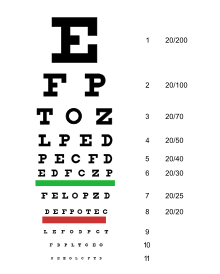Acute visual loss
| Acute visual loss | |
|---|---|
| Other names | Acute vision loss |
 | |
| A Snellen chart, which is frequently used for visual acuity testing | |
Acute visual loss is a rapid loss of the ability to see. It is caused by many ocular conditions like retinal detachment, glaucoma, macular degeneration, and giant cell arteritis, etc.
Main causes
[edit]Retinal detachment
[edit]Retinal detachment should be considered if there were preceding flashes or floaters, or if there is a new visual field defect in one eye.[2][3] If treated early enough, retinal tear and detachment can have a good outcome.[2]
Glaucoma
[edit]Angle-closure glaucoma should be considered if there is painful loss of vision with a red eye, nausea or vomiting.[4] The eye pressure will be very high typically greater than 40 mmHg.[5] Emergent laser treatment to the iris may prevent blindness.[4]
Macular degeneration
[edit]Wet macular degeneration should be considered in older people with new distortion of their vision with bleeding in the macula.[6][7] Vision can often be regained with prompt eye injections with anti-VEGF agents.[6]
Giant cell arteritis
[edit]Giant cell arteritis should be considered in an older person with jaw claudication, temporal pain, and tiredness.[8] Placing the person on steroids might save both their vision and decrease their risk of stroke.[9] Without treatment a person can quickly go blind in both eyes.[10]
Vascular occlusions
[edit]- Central retinal artery occlusion: CRAO is characterized by painless, acute vision loss in one eye.[11]
- Central retinal vein occlusion: CRVO causes sudden, painless vision loss that can be mild to severe. [12]
- Branch retinal vein occlusion: sudden painless vision loss or visual field defect are the main symptom of BRVO. [13]
- Branch retinal artery occlusion: BRAO may also cause acute painless loss of vision. [14]
Vitreous hemorrhage
[edit]It is one of the most common causes of acute or subacute decrease in vision. [15]
Hyphema
[edit]Blood in the anterior chamber of the eye is known as hyphema. Severe hyphema covering pupillary area can cause sudden decrease in vision.
References
[edit]- ^ "Acute Visual Loss - MEDSKL". medskl.com. Retrieved 23 January 2019. (Video's script with inline references)
- ^ a b Fraser, S; Steel, D (24 November 2010). "Retinal detachment". BMJ Clinical Evidence. 2010. PMC 3275330. PMID 21406128.
- ^ "Facts About Retinal Detachment". National Eye Institute. October 2009. Archived from the original on 28 July 2016. Retrieved 26 July 2016.
- ^ a b "Facts About Glaucoma". National Eye Institute. Archived from the original on 28 March 2016. Retrieved 29 March 2016.
- ^ Simcock, Peter; Burger, Andre (2015). Fast Facts: Ophthalmology. Karger Medical and Scientific Publishers. p. 25. ISBN 9781908541727.
- ^ a b "Facts About Age-Related Macular Degeneration". National Eye Institute. June 2015. Archived from the original on 22 December 2015. Retrieved 21 December 2015.
- ^ Brown, Thomas Andrew; Shah, Sonali J. (2013). USMLE Step 1 Secrets3: USMLE Step 1 Secrets. Elsevier Health Sciences. p. 576. ISBN 978-0323085144.
- ^ "Giant Cell Arteritis". National Institute of Arthritis and Musculoskeletal and Skin Diseases. 13 April 2017. Archived from the original on 22 October 2017. Retrieved 21 October 2017.
- ^ "Giant Cell Arteritis". National Institute of Arthritis and Musculoskeletal and Skin Diseases. 13 April 2017. Retrieved 19 October 2018.
- ^ Solomon, Caren G.; Weyand, Cornelia M.; Goronzy, Jörg J. (2014). "Giant-Cell Arteritis and Polymyalgia Rheumatica". New England Journal of Medicine. 371 (1): 50–7. doi:10.1056/NEJMcp1214825. PMC 4277693. PMID 24988557.
- ^ Varma DD, Cugati S, Lee AW, Chen CS (June 2013). "A review of central retinal artery occlusion: clinical presentation and management". Eye. 27 (6): 688–97. doi:10.1038/eye.2013.25. PMC 3682348. PMID 23470793.
- ^ "Eye Strokes: CRAO, BRVO And Other Retinal Artery And Vein Occlusions".
- ^ Musa Abdelaziz, MD, Mahdi Rostamizadeh, Baseer Ahmad, MD. "Branch retinal vein occlusion".
{{cite web}}: CS1 maint: multiple names: authors list (link) - ^ Matthew Santos, Robert H. Janigian, Jr. M.D. "Branch retinal artery occlusion".
{{cite web}}: CS1 maint: multiple names: authors list (link) - ^ John P. Berdahl, MD, and Prithvi Mruthyunjaya, MD (March 2007). "Vitreous Hemorrhage: Diagnosis and Treatment".
{{cite web}}: CS1 maint: multiple names: authors list (link)
